

Katherine Kolar - NanoJapan 2015
Central Michigan University
Major: Electrical Engineering and Mathematics
Class Standing: Sophomore
Anticipated Graduation: May 2018
NanoJapan Research Lab: Profs. Nobuyuki Aoki & Yuichi Ochiai, Chiba University
NanoJapan Research Project: ![]()
Why NanoJapan?
NanoJapan inspires the growth of science, engineering, knowledge, culture, and global friendships. Physicists and engineers often work together to improve quality of life and discover new things. Connecting students of physics and engineering means developing international relationships that create new ways of thinking which allow our global community’s progression to a better place. I think NanoJapan will teach me new ways of theoretical and practical problem solving that I can apply to every subject I learn in future classes. I am eager to learn Japanese, experience a new culture, and explore a beautiful country this summer. Above all, I am excited to learn more about the research happening in Japan and get hands-on nanotechnology experience.
At the end of the program, my only addition to my previous assessment of the meaning of NanoJapan is that a large part of this program is about building relationships with diverse groups of people and learning about different walks of life while still focusing on science and technology.
My goals for this summer are to:
Research Internship Overview
My research experience in Japan can be divided into two parts. During the first part of my experience I learned fabrication methods and was able to fabricate a bi-layer graphene on silicon device. The second part of my project was the characterization and data analysis of an h-BN/graphene/h-BN device that had been fabricated by my mentor before I arrived in Japan. The characterization was done to study conductance fluctuations of preserved graphene at low temperatures. Both parts of my research experience were meaningful because they both relate to what I am choosing to study in my undergraduate career. Fabrication relates to the engineering side of my while the device characterization and analysis helped me to learn a lot about physics and I think this can only academically help my future.
Working in an international setting was difficult at some points because meetings and presentations that I attended were not in English. This meant that there wasn’t a way for me to pick up information or tune into discussions throughout the time in my lab, but I had to know the right questions to ask and when to ask them. Though there were definitely difficult aspects of being in a non-English speaking lab, I think that the cultural learning experience was worth it. I got to learn so much about the Japanese language and culture through making new friends and growing relationships with Japanese people.
Walking away from this experience, I think it has definitely helped me realize that my future research endeavors will focus more on fabrication and the engineering of devices and materials. This experience also showed me the importance of not only considering the content of research in a lab, but I need to consider the working environment of the lab that I choose to work in to ensure my success as a collaborator and student.
The lab environment in Chiba was very friendly and everyone was very welcoming to newcomers. All of the students follow the direction of the person who works above them (generally the person who has been there longer), and everyone reports back to the professors for each step of their research project and progress. My mentor was really nice and open. Everyone in the lab seemed to have a sense of humor, but there was always the distinct feeling that we were there to work. There was definitely some socializing outside of the lab and usually group dinners took place when everyone was working late. Overall, everyone in the lab was extremely nice and I hope to see them again when I can find my way back to Japan.
Daily Life in Japan
My daily life during my research experience in Japan was fairly predictable. I would wake up, stop at a combini for a yogurt and then get to work by 10 am. Once I was at work, we would either experiment or have meetings starting at 10:30 and then break for lunch around 12. Lunch consisted of a quick run to the on-campus combini to get o-nigiri and a juice and then go back to work. During the first part of my research internship, I generally had dinner with lab members a few times a week and was able to leave the lab at around 8 pm. In the second part of my internship, a lot of testing needed to be done so I ended up leaving the lab after 11 o’clock on most nights. Generally we stayed as long as work needed to be done.
My weekends were mainly taken up by hanging out with other students (KIP and NanoJapan) in Tokyo and going shopping. There were a couple of weekends that we traveled further than Tokyo to go to places like Kyoto, but I loved getting to know the Chiba/Tokyo area and hanging out with people after hard weeks of work. It was also nicer to stay near Chiba because there were some weekends that I was needed in the lab and this way I didn’t need to drop a lot of travel plans when I was called in.
Complete the following sentences
Up to this point, my experience in Japan has been filled with some amazing excursions and a lot of learning. I expected Japan to have traditional Japanese values and culture, with high fashion and advanced technology. I thought of Tokyo as a huge, bright, and constantly bustling city with crowds everywhere. I’ve come to realize that even though some of the previously mentioned attributes do exist, they don’t actually describe the city accurately.
Visually, Japan has been surprisingly similar to America. Skyscrapers and architecture are much cooler than my hometown, but definitely resemble the style and height of buildings in large American cities. One thing that has definitely been surprising has been the fact that the different districts of Tokyo are dramatically different. It makes being in Tokyo even cooler because it truly feels like we are able to experience different parts of Japanese culture by seeing the different aspects of every district. In Azabu-Juban, for instance, nearly everyone wears nice business clothing of generally neutral colors. The streets tend to be quiet with many people heading to jobs or school. Though it is definitely populated, Azabu-Juban differs greatly from areas like Shinjuku and Shibuya, which get extremely crowded. Areas like these are also filled with billboards, screens, and neon lights. Even the people that populate areas like Shinjuku and Shibuya tend to wear less conservative clothing and be more boisterous. I have really appreciated getting to see the different moods/energies of a few of the different parts of Tokyo in this first week.
I think that the food is generally what I expected it to be before coming to Japan. The cuisine consists of a lot of rice and noodles of different types. There is raw fish sold almost everywhere and the green tea, red bean, and mochi are amazing! I will say though, even though we were warned about the expense of vegetables and fruit, I am still shocked by it. It is pretty clear that many people must go with very little fruit or vegetables because these things are not only expensive but there isn’t a large supply of them. Nonetheless, the food is amazing and for the most part fresher than in the United States. So far, I really love being here and each passing day becomes a brand new learning experience.
The Japanese language has been difficult for me to learn thus far. Language classes are really intense and some days it’s hard to find a free moment to study. I am progressing though, and as we build upon our vocabulary things are becoming easier. So far, I have been doing the homework and looking at the vocabulary we’re learning every night before I go to bed. This week, I’m planning on using the book more and creating flashcards to help me (I am definitely a flashcard type of student). A huge help has definitely been our teachers. Working with native Japanese speakers everyday has been extremely helpful. We’re getting accustomed to different accents and teaching styles, which is a huge help considering in two weeks we will be hearing many different Japanese speakers in our labs.
Question of the Week
Even though we have spent only a week here, it is difficult to think of a question. Packard-sensei has been extremely helpful and a great person to turn to for all of our immediate questions. Though there may be no good answer to this question, I’d like to ask if there is any clever way to integrate more fruits and vegetables into our daily diets, here in Japan?
NanoJapan Tips: Look for discount grocery stores that sell fruit and vegetables that didn't quite make the cut for the nice supermarkets. These may be hard to find in Azabu-juban (a pretty wealthy neighborhood), but may be easier to find near your research internship housing. Try to add as much tofu as you can into your diet and check out the tofu store/stand that is right near the Sanuki Club (I highly recommend their tofu donuts). Once you get to your research internship housing and have access to a kitchen, try to use frozen vegetables and fruits in your cooking as they can often be cheaper. Also, remember that there are a wide range of vegetables in Japan that are different from what's commonly available in the U.S. so experiment with some of these in your cooking as well. Finally, here is a helpful blog on budget grocery shoping in Japan.
Intro to Nanoscience Seminar
Heading into this week, I was nervous that I would be behind as far as the nanoscience lectures go, but I found them to be really enlightening. I thought that the classes moved at a good pace. I was able to take really helpful notes and get an idea of what we’ll be working on while in Japan. I felt like this class was taught as an intro course, and I think this was perfect for our group since we all have different backgrounds. I don’t have any questions at this point because I am still working to understand the jest of my project. After reading more papers, I think I’ll be able to ask my mentor, Aoki-sensei, or Dr. Bird more questions next week.
Intial Research Internship Overview
During my research internship I think will be studying the transport properties of graphene with BN layers as upper and lower insulators. Graphene is a zero-gap semiconductor, while boron-nitride is a semiconductor with a large band gap. Graphene is a 2D system. I believe I will be studying the magneto-transport properties of the fabricated samples already in the lab. I am not sure yet what experimental methods I will be using but I do know that I will be testing at low temperatures. More information to come!
Visiting Nagano prefecture will undoubtedly be one of the most memorable experiences I’ll have when looking back on my time in Japan. We learned about Japanese culture through meeting new people and participating in once-in-a-lifetime activities. By the end of our first night in Nagano, I had ridden the Shinkansen, planted rice, experienced an onsen, had a traditional Japanese dinner, then saw and participated in my first taiko drumming performance. The trip only got better as the next day was spent having a discussion at Shinshu University, meeting and talking with local farmers, and attending a barbeque with many Japanese people. On our last day in Nagano, we learned how to make soba noodles and eat them, visited the Aoki-Mura shrine, and then were able to hang out with Ueda High School students while getting a tour of Ueda castle and had the opportunity for an extra excursion of our choice with them. My group took fun photos called purikura, a common pastime for Japanese girls.
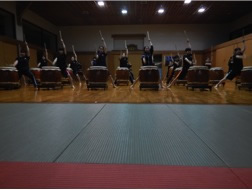
Watching a taiko drumming performance, some of the kids were as young as 8 years old! So much talent!
There were so many parts of this trip that had an impact on me. Being welcomed so graciously by everyone we encountered really made me think about cultural acceptance and interest across the globe. Even though many of us speak very little Japanese, each experience was full of communication and kindness. Upon arriving to the farm where we planted rice, we were invited to sit down and enjoy tea and snacks that the family who owned the farm had prepared for us. We were able to experience being a guest to a Japanese home first-hand, which served as not only a very kind gesture on the part of the family that hosted us, but the experience also served as a great opportunity to learn about Japanese culture for all of us. Another thing that will always stand out to me was our visit to the Ueda High School. Once again, the students and faculty that received us, went out of their way to make us feel important. As we first walked into the classroom where we would be meeting the students, we were being clapped for the whole time. They then proceeded to play the American National Anthem and sing it with us. I think them singing with us really surprised me because since we’ve gotten here we have heard a lot about Japanese nationalism and pride. Watching students stand with us, put their hands on their hearts, then sing with us really showed the effort that Ueda High School is putting forth to globalize their students and community.
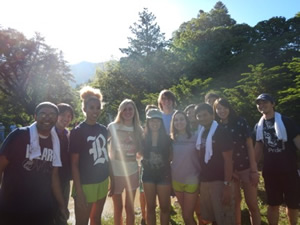
Just finished planting rice for our first time!
During this trip, I’ve been trying to not set specific expectations for our excursions and take in the culture as I go. As far as my expectations for Nagano, I think that the Japanese countryside was just as meticulous and beautiful as the rest of the country is. I was definitely surprised at the sheer amount of people that we met in three days, and how quickly we were able to make friends with everyone beyond some language barriers. The statistic about how little communication is actually verbal has been slowly but surely proving itself to be true as our trip is progressing.
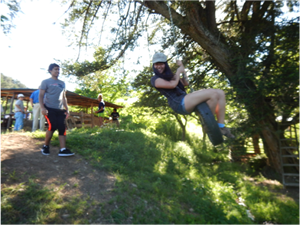
Rebecca tire-swinging on the farm we visited in Aoki-Mura!
Our communication with many of the villagers seemed very open. Even though Japanese shyness has been prevalent in some of our experiences here, Nagano seemed to contrast from this attitude quite a bit. During the barbeque, some of us even participated in a Japanese dance around the fire with some of the villagers from Aoki-Mura. One cultural pattern that I noticed during our time in Nagano was that there is a very specific way to go about many aspects of life in Japan. Whether it be eating certain foods, participating in onsen, planting rice, performing taiko, or even sleeping in the ryokan, there is generally a certain way to go about each activity. For the rest of the summer I want to keep this in mind and remember to constantly be paying attention to what the people around me are doing, or when in doubt ask the people around me what appropriate actions may be regarding certain gatherings or rituals.
Intro to Nanoscience Lectures
This week’s lectures were extremely helpful because there was a lot of material taught regarding carbon and graphene. We went over things like resistance and conductivity and their relation to temperature in semiconductors. We also went over things like bandgaps again and strategies to get carbon nanotubes. I really enjoyed the closing part of the lecture that went over vacuum filtration, polarization properties of carbon, and then applications of carbon nanotubes and graphene. This week’s lectures felt especially relevant to what I’ll be working on this summer because I’ll be working directly with graphene, like many of the other students in our group who will also be working with carbon nanostructures. I think one thing that I’m hoping to hear more about in this upcoming week would be density of states because I’m not as familiar with subject but it has repeatedly come up in our nanoscience lectures.
Preapration for Research Internship - Article Review
The most recent paper that I’ve been working to understand is one titled, “Robust Mesoscopic Fluctuations in Disordered Graphene”. It is published by the American Institute of Physics and authored by Aoki-sensei, Ochiai-sensei, Dr. Bird, and others.
G. Bohra, R. Somphonsane, N. Aoki (青木伸之), Y. Ochiai (落合勇一), D. K. Ferry and J. P. Bird. “Robust Mesoscopic Fluctuations in Disordered Graphene," Appl. Phys. Lett. 101, 093110 (2012). http://dx.doi.org/10.1063/1.4748167
This paper was sent to me by Minehara-san who will be my mentor when I get to Chiba in one week. The paper begins by discussing a couple of the pros and cons of graphene based nanoelectronics. It is pointed out that graphene has a structure that is classified as zero bandgap and has large carrier mobilities. Even though graphene has applications in nanoelectronics due to to the fact that it is highly electroconductive and quite strong, a nonexistent bandgap can make graphene quite a challenge to work with. The paper then goes on to dicuss the fact that as of late, transport studies show evidence of weak localization and conductance fluctuations in graphene. Though these mesoscopic effects may be somewhat standard when discussing other semiconductors, the data received from testing graphene implies that graphene has much more complicated traits.
The paper then goes on to discuss how the conductance fluctuations change with increasing temperature. It has been found that there are two separate cut offs for the two types of fluctuations that occur during such testing. When magnetic-field inducted fluctuations occur, they are insignificant around 10 K. Contrastingly, fluctuations generated by carrier density can be detected beyond temperatures in the range of 100 K. This shows how graphene is atypical as far as conventional semiconductor behavior and traits such as these can be used to find applications of graphene in nanodevices.
The rest of the paper is quite interesting as it goes into detail regarding the fabrication of the graphene devices that were tested in the experiments used to draw the previously stated conclusions. Of the six devices that were tested, two were bilayer, and four monolayer. The devices were created using a method that involved exfoliating graphite onto a layer of SiO2 and then covering that with a doped layer of Silicon. Figures are then reported showing the variation in conductance with temperature, magnetic conductance obtained from the application of a magnetic field normal to the graphene at different temperatures, and the variation of the energy correlation function for both the monolayer and bilayer devices.
The conclusion of this paper discusses the likelihood that conductance fluctuations are dependent on the density of the sample of disordered graphene. The magnetic-field and gate-voltage induced conductance fluctuations are also discussed as showing a unique quantum transport characteristic of graphene. In order to learn more about the density dependence of the results reported in this paper, the publication closes with comments about performing more testing using graphene that is not as disordered or suspended above a substrate.
Public transportation in Tokyo has been fairly similar to the public transportation in other large cities around the world, except the trains are always on time. There are many trains that have stops everywhere in the city, and when traveling by train, a strict time schedule can actually be followed. The signage tends to be helpful because in Tokyo there is English under all of the Japanese so navigating the system isn’t too difficult of a task. Some of the things that non-Japanese people may find, though, are behavioral patterns that the majority of people follow when using public transportation. Generally, people focus on taking up as little room as possible. This means that when sitting, you rarely to never see someone with their legs crossed or protruding into the space in front of them. I noticed once that when I put one leg over my other one, people avoided standing in front of me because my foot was slightly farther out than the people around me. As soon as I realized my mistake and put my foot down, people then moved to be in front of me again. It’s all about being mindful of those around you. Generally when it comes to sitting, people will avoid sitting next to strangers if they can, and generally the seats get taken before people choose to stand. During rush hour when the subway is extremely busy, people pack into the train like sardines. There is no fear of pushing or even touching people you don’t know if it means getting to the train on time, though I’ve noticed that this pushing happens no matter what the time of day it is. If people need to get out of the train and you’re not going fast enough, or you’re in their way, they will shove past you to get where they need to go.
Another observation that can be made about the public transportation is how quiet the people are when using it. People either read or play games on their phone and rarely talk. It is actually extremely helpful when trying to hear announcements being made throughout the station or the train. On the down side though, this means that if you’re talking then everyone within your vicinity can hear you and it’s treated as a disturbance in some cases. This is very different from other cities I’ve been to where people are constantly talking and not necessarily paying attention to what the people around them are doing. Other than the talking aspect of traveling with others, I think that the way the Tokyo public transportation works is what would be expected as far as movement of people and logistics of trains.
When looking back on the past three weeks and thinking about whether the differences I’ve been noticing between Japan and America are cultural or just practical, I’d have to say that it is a mix of both. I think that the importance of blending and not disturbing those around you is a great example of a mix between a cultural difference and a practicality on the part of the Japanese culture. It shows their longing for harmony and their consideration of the feelings of every person around them. Americans are highly individualistic, and value an individual who stands out among the crowd even if it upsets others. Overall, I’ve really loved my past three weeks in Tokyo. Japan is a beautiful place with beautiful culture. In honor of it being our last week of language classes, I’ve made all of my photos this week showing parts of our walk to class and then of the last day of the class itself. Enjoy!
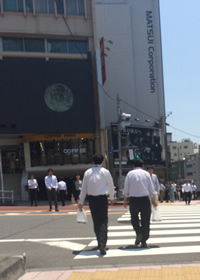
This is a photo of the usual scene walking back from class everyday. It is easy to see what the basic Japanese work outfit looks like!
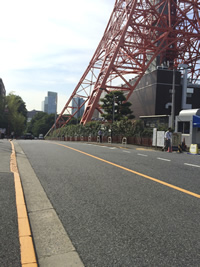
Picture from outside the building where we attend our classes…at the foot of Tokyo Tower!
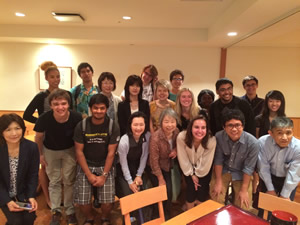
Last day of class before heading to our labs!
Intro to Nanoscience Lectures
This week Dr. Bird gave very informative lectures covering the basics of nanoscience. It was great to learn about many of the explanations and definitions behind the words that we’ve been reading in our papers. I think that this was the perfect lecture for me this week because it answered many of my questions regarding transistors and heterostructures.
We arrived to the lab on Monday morning at 10:30 to begin our day. Upon walking into the lab, we got many hellos and put our things by the desks that would be ours for the next couple months. Most of the details are a blur, but throughout the day we got some paperwork to fill out in order to get our student IDs and a tour of the clean room. My mentor, Mineharu-san, showed me some of the equipment being used for fabrication, the optical microscope images of the graphene h-BN fabricated devices, and also the lithography machine. Everyone here is so welcoming, and I’m really excited to get to work in this lab.
We had our welcome lunch on Thursday, which was really fun because about 25 people were there! Near the end of the lunch, some of the lab mates disappeared and then came back with a birthday cake for me. When Mineharu-san asked me how old I was on Monday, I had told him that I was turning twenty on Thursday, and I can’t believe that he remembered, and that the lab went out of their way to celebrate it with me. I think this really speaks to what caring and kind people are working in this lab, and this gesture meant a lot to me…it’ll be something that I never forget.
As previously stated, my mentor is Mineharu-san. He’s currently working on getting his Master’s degree here at Chiba University. I’m really glad he’s my mentor because our personalities seem to mesh well, and he’s really patient about my terrible attempts at Japanese. I also work with Matsumoto-san at times, who is a senior at Chiba University and is currently working on the fabrication that I’ll be taking part in for the next couple weeks. He’s a little more shy than Mineharu-san when it comes to speaking English, but still a really nice person just like most everyone else here.
I think amongst the NanoJapan program it is well understood that the Chiba Lab is one of the only all-Japanese labs that students are sent to – and it is. Every single member of this lab is Japanese, and our research meetings are conducted completely in Japanese. With this being said, it doesn’t mean that no one in this lab speaks English. In fact, to this point I’ve found the instances where a language barrier has been apparent to be more like fun challenges, and less like hindering occurrences. Even though it is clear that some of the other students are not comfortable speaking English, they’ll still let you struggle through half Japanese-half English conversations with them, and laugh along the way. There is definitely an atmosphere of teamwork here, and I’ve loved being surrounded by a true Japanese lab culture so far.
The housing here is pretty nice and it’s about a thirty minute commute from the lab. It’s been so hot that I haven’t tried walking to the lab yet, and have just been taking the metro. Our rooms are really great because we have our own bathrooms and air conditioning. One thing that I’ve yet to find, though, is a nearby hundred-yen store. I still have lots of exploration to do as far as Chiba goes, and I’m interested to see what I find.
Assessment of Orientation Program and Language Classes
Overall, I loved the orientation program. I think that the cultural aspects were not only fun, but they were great learning experiences. Being in an all-Japanese lab, I can safely say that I feel culturally prepared to be here through the different discussions and observations we were able to have during the past three weeks. The most helpful activities were definitely our discussions with Packard-sensei, the KIP students, and our trip to Nagano. All of these things put us in direct contact with Japanese culture that is unparalleled experiences we would’ve had just traveling around Japan.
So far, I feel that though I know some key phrases and words in Japanese, I am not linguistically where I hoped to be at this point in the trip. In the past, I’ve been a very linguistic person and have never found language this difficult to pick up. As far as the rest of the summer, I am hoping to be able to attend some of the beginner Japanese language classes at Chiba, and continue with self-study. I definitely have the means to practice all of the Japanese I learn, seeing as the language surrounds me all day.
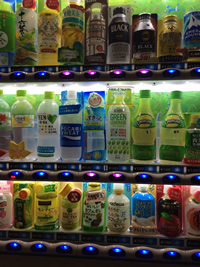
Going to miss the vending machines!
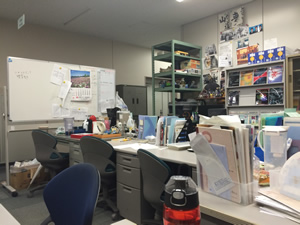
Here is the view from my desk in the lab!
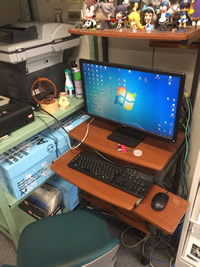
This is one of the desks in our lab…love all of the figurines!
Research Update
As far as my research project goes, I haven’t started taking low-temperature measurements of the graphene h-BN devices that Mineharu-san has fabricated. There are currently other people using the equipment I need, so the data collection for my project won’t start for another couple weeks. Until I am able take more data, I’ll be working on fabrication of graphene SiO2 devices. Last week, I watched Matsumoto-san do some work on these devices, and Mineharu-san had a session with us both together, to show us the first steps in the fabrication.
Research Project Overview: My project will have to do with the characterization of a fabricated graphene h-BN device. I will be studying the magneto-transport properties of this device at low temperatures.
Timeline: For the next few weeks I will be learning fabrication methods for graphene onto different substrates. Once the machinery is available, I’ll be working on characterizing the graphene h-BN samples for the rest of the summer.
I can’t believe that we’ve been in Japan for over five weeks now. Time has flown by since coming here because everyday is used going on new adventures and learning new things. Reflecting on everything we’ve been able to see and accomplish so far makes me even more excited for the second half of our stay here. So far, I haven’t had any major issues with cross-cultural communication. In fact, I have found everyone here to be not only welcoming, but also open and understanding. Between Packard-sensei, the KIP students, and everyone in the Chiba lab (especially my mentor), I’ve been able to ask questions and clarify societal norms as needed.
One thing that becomes quickly apparent when experiencing a new culture for the first time is the significance of nonverbal communication. Body language, facial expressions and hand gestures are an important and useful way of being able to get a message across when language barriers come into play. When first coming to Japan, I was happy that most of my American gestures were universal, and it wasn’t too difficult to communicate basing things, like yes or no. Nodding or shaking the head is a natural reaction for me during many situations, and not needing to relearn most of my comfortable gestures has been a major plus.
I’ve really enjoyed learning some of the common Japanese gestures and the meaning behind them. For example, generally when referring to yourself, an American will touch their chest. In Japan, when referring to oneself, a Japanese person will point to their nose.
Last weekend, when hanging out with some of the KIP students, we were asking them which Japanese hand gestures had very negative connotations We learned that even though “thumbs up” has a similar meaning to the American usage, “thumbs down” is actually seen as a very negative gesture when directing it at someone else. I was immediately worried because I had been walking around using the “thumbs up” and “thumbs down” method in my lab in meaning yes or no/okay or not okay. Looking back, I don’t remember any of my lab members acting out of the ordinary when I used this gesture, but this could be because the meaning was implied, and everyone knows I’m not completely familiar with Japanese culture.
I definitely haven’t done any more “thumbs down” in lab, but instead will put my fingers in an “X” to check if I’ve done something wrong or not. After thinking about it more, I realized that there could be other gestures I’ve been doing without even realizing it. When looking up common Japanese gestures, I was relieved to find that there aren’t any offensive ones that I would naturally do. I think that researching and knowing gestures other cultures use is really important because gestures are a major form of communication.
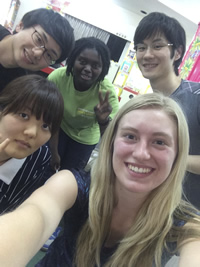
Bowling with our mentors!
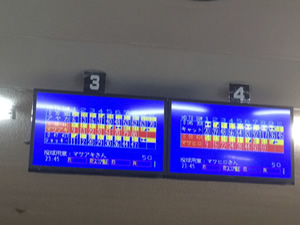
Best I’ve ever bowled…after four “warm-up” games!
Research Project Update
In the past week, we have worked on fabricating a transistor using graphene on an SiO2 substrate. We preformed annealing on the sample we had of graphene on the SiO2. After annealing, we spin coated a V90 photoresist onto the substrate. We then did photolithography on the substrate and started trying to perform deposition of gold and chromium onto the substrate. Unfortunately, something went wrong with the deposition so we’ll have to go back and rework the sample.
The project that I’m going to be working on with low-temperature measurements of a substrate composed of graphene on h-BN has not officially started because the equipment I need is still in use by other researchers.
This week marks the halfway point of our summer in Japan, and the time has gone by even more quickly than I imagined it would. I think that my biggest personal accomplishment so far has been speaking with people in Japanese. At this point I’ve had some conversations with Japanese people where English is never used, and I am completely aware of what is being said. Even though these conversations are extremely basic in terms of vocabulary and subject matter, it is still a really encouraging feeling to know that my Japanese is improving and I do know ways to communicate.
I’ve also been proud of the fact that I’m comfortable with independently travelling around Japan. Sometimes travel here can be very intimidating because signage isn’t always clear and when getting further away from the large cities there is less and less English to rely on. During the first three weeks here, we did a lot of group travel and I would only go off on my own around Azabu-Juban. It’s been really nice feeling free to go around Chiba, or travel into Tokyo, and meet up with friends or go shopping without hesitation. There is also something to be said for not having to think about waiting or working to stay in a large group of travelers. This past weekend, I went and explored around Inage and ended up finding many different parks, Shrines, and cool stores that I plan on returning to during our last few weeks here. Being comfortable with going around Japan has made this entire experience much more enjoyable and is really making Japan feel like a home away from home.
So far, I think my biggest personal challenge on this journey has been feeling so far removed from life in the U.S. During the first three weeks we were here, there were spans of days where my devices couldn’t connect to the Internet, and it was difficult for me to communicate with friends and family. I think going from a life where it’s almost impossible to disconnect from social circles, to a situation where it is extremely difficult to connect can be shocking at first. There were points where I felt bad because the lack of communication I had with people was not only an adjustment on my part, but on theirs as well. Now that I’m in Chiba, it has been much easier to talk with people and I’ve gotten used to planning around the time difference to conveniently talk to friends and family.
I also think that the feeling of removal from the U.S. is amplified because the time period that we’ve been here has also been quite significant for America. The time difference sometimes makes it difficult to keep up with current events, because news that may be brand new to us has already been buzzing in America for a day or more. It has definitely been an odd feeling to read about home, or hear about America on the news as if it’s a far off place.
My research hasn’t officially started yet because the equipment I need has been in use for the past few weeks. I’ve still been working on fabrication of other samples and learning about graphene in the spare time that I’ve had, so my time here has still been very fulfilling.
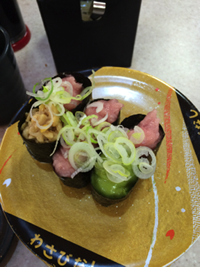
Found some of my new favorite makisushi when out to dinner with some labmates! おいしかったです!
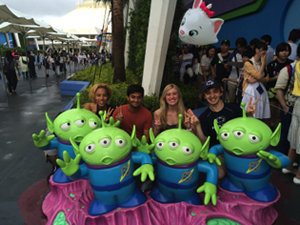
Tokyo Disney was absolutely amazing! A much needed day of fun with friends :)
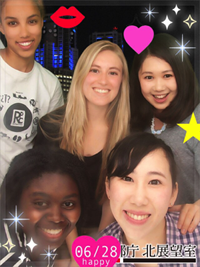
Japanese-style photobooth called a プリクラ(Purikura)! We had so much fun taking these at the top of the Tokyo Metropolitan Government Building in Shinjuku!
Research Project Update
This week I learned how to perform conductivity and resistivity measurements on the two-terminal bi-layer graphene on SiO2 sample that my mentor has helped me fabricate. I am still waiting to start my project, as the 3He cryostat has just become available for use. I should be much busier after we get back from Okinawa.
I think my language skills have improved since the end of orientation week. I find understanding Japanese speakers comes a lot more easily to me now and I’ve added useful words to my vocabulary. I’m continuing to study Japanese by asking my mentor a lot of questions, translating children’s books and attending classes two times a week. I think the biggest linguistic challenge lies within the research aspect of my experience. For the first few weeks I was here the cryostat wasn’t ready for use and so I was reading papers given to me by my mentor. I thought I understood my project, but as it turns out, the physics behind the data that we’re collecting is more complicated than I had anticipated, and now that testing has begun, I can see that most of the data analysis and discussion will be happening in Japanese. This means that I’m going to be more proactive about asking questions and utilizing resources outside of the lab to make sure that I understand what is going on. I think that the most effective technique to understanding the Japanese around me has been to write down words and either look them up or ask what they mean. There are some words that are used very often and understanding these can make a world of difference as far as having an idea of what is going on around you.
Being in Japan has made me realize how important being able to speak Japanese is if you plan to be here for an elongated period of time or create lasting relationships. If I continue my Japanese study, I think that classroom study is very beneficial for things like grammar and kanji memorization, but I now know the value of constantly using what you learn in the classroom to converse with Japanese speakers. I think that one of the best ways to learn and remember Japanese is to be constantly using it, which is why being in the Chiba Lab has helped me immensely with my language study.
The Mid-Program Meeting, though stressful at times, was also really fun. Hearing how much progress everyone else had made in their project gave me a huge stress-out moment, but upon getting back to the lab and starting to do a lot of work on my project, I realized that a lot of my stress was over things that I couldn’t control so there was no use stressing over it. For the rest of the summer, I’m going to try my best to be as helpful and contribute as much to my project as I can, while continuing to learn Japanese and grow relationships with some of the great people I’ve met in Japan.
OIST was an amazing place to see and I’m so glad that this is where our Mid-Program Meeting took place. The campus is incredibly beautiful, and the whole school feels almost like a paradise. OIST had the most diverse population I have seen since coming to Japan, and being surrounded by fluent English speakers again felt almost strange. I think that in a small way OIST was a culture shock, especially because the OIST makes it a goal to keep a decent gender ratio of scientists, which is difficult to find at most institutions in America, let alone Japan. Being at OIST definitely made me consider applying there for future academics because their program is so unique and caters to each student. I am still not quite sure exactly what I’ll want to do in graduate school, so OIST’s beginning part of the program when each student tries out different types of sciences would probably benefit a student in my position greatly. I still have a lot to consider when it comes to furthering my education, but OIST may be a viable option for me as the next couple of years go by.
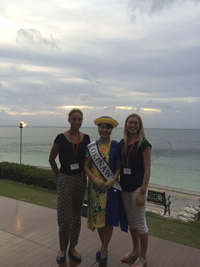
Meeting Miss Okinawa at the MTSA Conference Banquet!
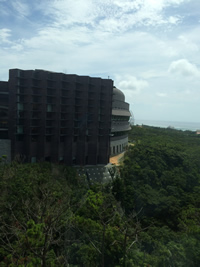
OIST has one of the most beautiful campuses I’ve seen.
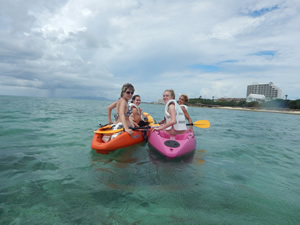
Using our free day to kayak at Moon Beach was so fun!
Research Project Update
My research has officially begun, so some data to come next week! Now that we’ve started the work has definitely kicked in and I’m rarely at my desk. The cryostat can sometimes be difficult when using it at very low temperatures, because it has a tendency to randomly increase temperature at a quick rate so we watch it closely. I have a lot of work to do as far as completely understanding the data analysis and I look forward to using my time to learn more.
Being in the lab for the fifth week now, the flow of everyday is feeling a lot more natural than it did in the first week or so of being here. There aren’t really set or spoken rules of the lab, though there is a hierarchy when it comes to communication. Generally, my mentor receives directions from our sensei and then tells me my part in completing the task. Depending on the experience of each person in the lab, in comparison to who is using their name, different honorific suffixes are used in daily speech (this is common in Japanese culture). For the time I’ve been here, there hasn’t been a situation where I’ve seen any disagreements in our lab because generally the students follow what their superiors tell them. I haven’t been truly surprised by anything in our lab because I felt like orientation prepared me well. I think that this lab is more formal than what was described to me in the sense that there is a definite hierarchy and work is taken extremely seriously. This contrasts from what I’ve heard about other labs from the other NanoJapan students, who claim their labs are quite lax when it comes to working hours, or professor/student friendships. I think that this could possibly stem from the fact that we are also the only lab this year that is comprised of a purely Japanese students and professors. I have noticed that foreigners are given quite a bit of leeway here, but since there aren’t really foreign students in our lab it is a lot easier to see the expectations that the Japanese professors have for the Japanese students.
Academic research in Japan is a little different than the U.S. in the sense that face-time is extremely important. What I mean is that putting in long hours, even though many of them may be unproductive, is highly valued. The term “hard-worker” has been thrown around quite a bit in this lab, almost always in reference to those who stay late and come in early. I think that this is a contrast from the U.S. because generally time not well spent is seen as time wasted, whereas in Japan it is not looked down upon to use lab time to do things not related to academics or research. With this being said, I think it is important to point out that progress is still highly valued in both countries. Even if lab time isn’t always used for research, it is still a clear goal that progress must be made each week in relation to the projects going on. There is also a big push for understanding scientific material in this lab, as there are weekly presentations on papers related to someone’s respective project, and weekly presentations on the progress that has been made this week. There is definitely a lot of hard work that happens in this lab and it has been quite inspirational to be a part of because everyone is very passionate about what they’re doing. As far as my preferred lab environment goes, I don’t think I could really make a huge distinction between America and Japan. I think that many lab traits are universal and lab cultures vary more with professors than with countries. I will say though, that at this point in my life I would have to choose an American lab culture by default because if I were a student in Japan, I would not be able to join a research group for another year. The fact that there are research opportunities for undergraduates of all grades in America has changed my life, and without that I may not be in Japan today.
Overall, I’m so happy that I was placed in the Chiba lab. Not only has my understanding of the Japanese language improved immensely, but my understanding of Japanese culture is much better now. I wanted a true Japanese lab experience, and I definitely think that I’ve gotten one. I’ve been challenged in ways that I have never experienced before, learned a lot about myself, and gained perspective on how to deal with certain situations and people that would have presented great difficulty to me before. There are still three weeks left of being here, and I can already feel how valuable this experience will be in my life moving forward.
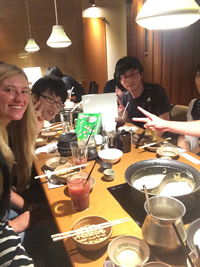
Out with lab mates!
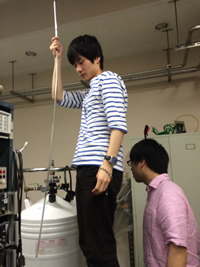
Working on the cryostat…really cool!
Research Update
This week we performed B-sweeps, Vg-sweeps, and temperature dependence measurements to study of our sample’s transport properties. The cryostat is a full-time job, as maintaining such low temperatures can be difficult and we put in a lot of hours everyday. There is a lot of work to be done seeing as both my mentor and I will be presenting the results of these tests in the next few weeks. My mentor is attending a conference in Sendai the week of July 27th and so we’re under a little bit of a time crunch to get and analyze data. The research has been really exciting and I’ve been learning a lot everyday. My only true difficulty this week was the fact that I’ve had a pretty severe cold and constant research doesn’t lend itself well to rest and recovery. My health is improving though, and I should be back to 100% by next week.
No report submitted.
After reading many articles regarding the controversy around Japanese researcher Obokata, I think that the events that unfolded are unfortunate. It is interesting to read the articles that were written before, during, and after her paper was investigated. Even though there were opinions that there shouldn’t have been focus on the fact that a female headed groundbreaking research (when it was still thought to be legitimate), I understand why it was. Though I do agree that the gender of a researcher shouldn’t affect the importance or perception of a publication, the current lack of women in the field does make the gender of researchers a relevant issue. Due to the fact that there was so much emphasis on the fact that Obokata is a female when the research results first came out, the focus remained on her femininity when her research started becoming questioned. I wish her the best as she moves forward in her career and hope that as time goes on, society becomes more accepting to diversity amongst researchers and realized that mistakes are made by people everyday, regardless of their gender, or anything else.
In regard to gender issues in Japanese research, I have taken note of a definite lack of women in the lab environment. Some of the other students have told me that they have no females in their labs and here in the Chiba lab, there is one female researcher. This is comparable to the situation of women researchers in America, but in America the lack of women is usually less extreme. I was surprised when reading more about the issue that the U.S. and Japan are actually quite similar when it comes to women working in research. I think that the bigger contrast between Japan and America comes when discussing women in the workforce in general.
I think that the overall gender issues in Japan are difficult to comment on because I haven’t been able to experience them first hand for a long period of time. Through discussions with Japanese girls that are my age, and the articles that I’ve read about the gender issues in Japan, I think that a large part of gender roles here are derived from societal pressure for women to become mothers and raise children without working. I think that once again, this is very similar to America.
Research Update
This is the last week of measurements and we have been collecting more data daily. After finishing data collection, more focus will be put on data analysis. Next week my mentor will be gone at a conference in Sendai and I’ll hopefully have more time to work on my poster.
It is hard to believe that I write this report with my research project finished and NanoJapan 2015 icoming to a fast end. I tried my best to keep an open mind throughout this program and think that this is definitely a goal I’m going to try and maintain for the rest of my life. Japan is a beautiful place with amazing people, and accepting cultural differences was key to my appreciation of it. I find that my attitude toward Japan has changed quite a bit since spending so much time immersed in Japanese culture. I am a lot more defensive of Japan now, especially when people far removed from it act as if Japanese values are alien to American values, so much so that the two cultures cannot have interconnections. Even though there are a lot of differences between America and Japan, there are a lot of parts of Japanese culture that I have learned from and grown to appreciate during my time in Japan. At the same time that I was growing appreciation for Japanese culture, I have also learned to appreciate certain things about American culture. I don’t think I have ever appreciated diversity so much in my life. It wasn’t until I got off of the plane and looked around the airport in Houston that it really hit me how much I had missed seeing people of mixed races cohabitating. I also noticed diversity in things that I hadn’t before, such as clothing, body type, and speech. I think that being back has really shown me how much individuality means to me.
Living and working in Japan really was such an amazing experience and there are so many things that I’m going to look back on with happiness and miss. The convenience of public transportation, vending machines, bakeries, and sushi are just a few of the things that I’m definitely going to miss from Japan. If I really think about it though, I’m going to miss the community of people that I met and became close with while in Japan most of all . I’m definitely going to miss hanging out with KIP and NanoJapan students around Tokyo and just having a fun time and laughing. I’m also going to miss seeing my mentor everyday and hanging out with my lab mates.
My experience in lab is definitely one I’m never going to forget. This experience has helped me a lot to narrow down what I would look for in future work environments. I still am not positive about exactly what career path I’d like to take in the future, but I think that maybe that’s a good thing because I’m not closing doors on any opportunities that may come my way.
My last week in lab was really relaxed because my mentor was actually at a conference in Sendai. It didn’t really hit me that I was leaving until he came back and the entire lab came out for a farewell party. Saying goodbye was a lot harder than I expected it would be. I think the fact that it was an open-ended goodbye made it a lot worse. I thankfully remembered to take a lot of pictures and get my mentor’s address. I plan on sending him an American thank you gift and card, as well as stay in touch with him through methods like LINE, Facebook and e-mail.
As far as research goes, I definitely would like to keep in touch with my lab and know how further results turn out. I don’t think I’ll be able to do a lot of research closely related to what I was doing in Japan as I continue research in America because the research that I did in Japan used very specific materials and instruments that aren’t readily available in most labs.
The last weekend we have in Asia will be spend traveling to Taiwan with Brandi. We’re taking advantage of being in another part of the world and trying to see as much of it as we can before heading back to America. Taiwan is going to be an amazing trip because we plan on seeing temples, markets, and other local Taiwanese places. We’ll then head back to Tokyo to hang out with all the NanoJapan-ers before our flight back to the U.S.
Final Research Project Update: ![]()
Project Title: Conductance Fluctuations in Fabricated h-BN/graphene/h-BN Devices at Low Temperatures
Host Lab: Chiba University – Quantum Nanodevice Group
Host Professors: Nobuyuki Aoki and Yuichi Ochiai
Mentor: Masaki Mineharu
Introduction: Research in this project is done on conductance fluctuations. Varying the magnetic field or gate voltage applied to a device generates conductance fluctuations, and then they are detected by probing the device for resistance or conductance. This project aims to not only contribute to the validity of conductance fluctuation existence, but to further help with the comparison of device quality among different graphene based nanodevices using conductance fluctuations as a tool to do so.
Approach: This project uses a cryostat to cool a fabricated h-BN/graphene/h-BN device to low temperatures (0.3-40K) and then apply a magnetic field perpendicular to the surface of the device. We then probe the device for resistance and/or conductance while we vary the temperature, magnetic field, or gate voltage. Both the quantum Hall effect and conductance fluctuations can be see in the graphs created from the collected data.
Results: Conductance fluctuations can definitely be seen in the collected data which is a really exciting result. They show amplitudes higher than 2e2/h directly from experimental data, before background is subtracted. It can also be seen that the magnetic field variation produces less temperature robust conductance fluctuations compared to the ones produced by the variation of gate voltage.
Discussion: It is clear by the results of this project that conductance fluctuations are real and clear enough to be used a gauge for device quality.
Future Research: More devices will be tested for conductance fluctuations and then results will be compared so that hopefully more trends and concise conclusions can be made about conductance fluctuations in nanodevices that have well preserved graphene.
My time in Japan was comprised of many amazing memories that compile to an experience I will never forget. I’ve grown emotionally in the sense that I am much more confident and able to be independent. Living on my own has taught me self-reliance in a way I had never learned it before. Beyond feeling better about travel and diving into the unexpected, my time in Japan has taught me empathy. Being able to meet so many wonderful people and discuss culture, science, and life experiences with them has changed my life. I have a new appreciation for how different parts of the world create lasting societies with so many different values.
If Japanese people know how to do one thing it is to work hard, and my time in the lab definitely reflected this trait. My time in the lab was spent doing two types of research. I started my experience learning fabrication methods. I was able to fabricate a bilayer graphene on silicon device with chromium and gold deposits. Contacts were made on the device using lithography and the graphene was mechanically exfoliated onto the silicon substrate. The second part of my research was using a 3He cryostat to perform low temperature characterization of an h-BN/graphene/h-BN device. I think that the most challenging part of navigating the lab was definitely learning the physics behind the data analysis that was going on, because discussions were all in Japanese. This meant that I needed to figure out the right questions to ask and reach out for help when I was in need of it. Overall, I was able to learn a lot about cross cultural work and communication while absorbing science along the way.
When I first realized that I would be working in an all Japanese-speaking lab when I got to Japan, I was intimidated to say the least. Upon arriving to Japan I only knew three Japanese words: konnichiwa, ohayō, and arigatō. Now that I can look back on my entire lab adventure, I couldn’t be happier with the fact that I was in a lab that spoke all Japanese. I think that my experience in Japan was truly authentic and I’m proud that I was able to acclimate and work in a culture and language that was totally new to me.
When talking to other students about my time in Japan, I would definitely tell them that I learned about the importance of not holding back. Looking back, I wish I had done even more to get myself out of my comfort zone. I think my biggest advice to myself in the future and to others would be to work hard, seek out opportunities, and always give your best effort.
In my future endeavors, whether they be research or industry focused, I have definitely realized how important it is to be able to blend into the environment you’re working in. I definitely prefer working in groups with open communication and collaboration. I’m also hoping to continue learning about other cultures and am going to work on keeping up with my Japanese language study.
Other Tips: